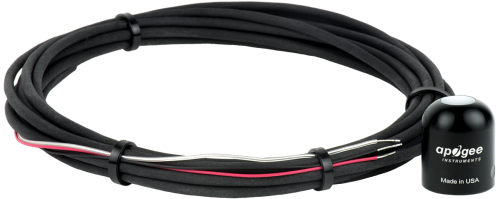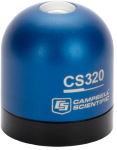This product is not available for new orders. We recommend ordering: CS301.

| Services Available |
|---|
Visão Geral
The CS300, manufactured by Apogee Instruments, measures total sun and sky solar radiation for solar, agricultural, meteorological, and hydrological applications. Its spectral range of 360 to 1120 nanometers encompasses most of the short-wave radiation that reaches the Earth's surface. This pyranometer connects directly to our data loggers. Its output can be measured by our data loggers.
Leia maisBenefícios e Características
- Compatible with most Campbell Scientific data loggers
- Designed for continuous, long-term, unattended operation in adverse conditions
- Measurement waveband of 360 to 1120 nm
- Dome-shaped head prevents water from accumulating on the sensor head
imagens




Produtos Relacionados
Descrição Técnica
The CS300 uses a silicon photovoltaic detector mounted in a cosine-corrected head to provide solar radiation measurements. Its dome-shaped head prevents water from accumulating on the sensor head. To eliminate internal condensation, the sensor head is potted solid and the cable is shielded with a rugged Santoprene casing. The CS300 is calibrated against a Kipp & Zonen CM21 thermopile pyranometer to accurately measure sun plus sky radiation.
Compatibilidade
Please note: The following shows notable compatibility information. It is not a comprehensive list of all compatible products.
Data Loggers
| Product | Compatible | Note |
|---|---|---|
| 21X (retired) | ||
| CR10 (retired) | ||
| CR1000 (retired) | ||
| CR1000X (retired) | ||
| CR10X (retired) | ||
| CR200X (retired) | ||
| CR206X (retired) | ||
| CR211X (retired) | ||
| CR216X (retired) | ||
| CR23X (retired) | ||
| CR295X (retired) | ||
| CR300 (retired) | ||
| CR3000 (retired) | ||
| CR310 | ||
| CR500 (retired) | ||
| CR5000 (retired) | ||
| CR510 (retired) | ||
| CR6 | ||
| CR800 (retired) | ||
| CR850 (retired) | ||
| CR9000 (retired) | ||
| CR9000X (retired) |
Additional Compatibility Information
Sensor Mounts
Accurate measurements require the sensor to be leveled using a 18356 leveling fixture. This leveling fixture incorporates a bubble level and three adjusting screws. The 18356 mounts to a crossarm or a tripod or tower mast using the CM225 mounting stand. The CS300 should be mounted away from all obstructions and reflective surfaces that might adversely effect the measurement.
Data Logger Considerations
One differential analog input channel per probe is required.
Especificações
| Spectral Range | 360 to 1120 nm (wavelengths where response is 10% of maximum) |
| Measurement Range | 0 to 2000 W/m2 (full sunlight ≈1000 W/m2) |
| Absolute Accuracy | ±5% for daily total radiation |
| Sensitivity | 5 mV/Wm-2 |
| Calibration Factor | 5 W/m2/mV |
| Cosine Correction Error | ±5% at 75° zenith angle; ±2% at 45° zenith angle |
| Temperature Response | 0.04 ± 0.04% per °C |
| Response Time | < 1 ms |
| Long-Term Stability | < 2% per year |
| Operating Temperature Range | -40° to +70°C |
| Relative Humidity Range | 0 to 100% |
| Output Sensitivity | 0.2 mV/W/m2 |
| Diameter | 2.4 cm (0.9 in.) |
| Height | 2.5 cm (1.0 in.) |
| Weight | 65 g (2.3 oz) with 2-m (6.6-ft) lead wire |
Documentos Relacionados
Lâminas do produto
Manuais
Perguntas Frequentes Relacionadas
Number of FAQs related to CS300-L: 9
Expandir todosRecolher todos
-
Campbell Scientific does not recommend splicing any cable into the existing cable. Splicing a cable could introduce water and electrical noise into the connection. The sensor can be ordered with longer cable lengths, and 50 m is right on the edge of the recommended length. With a cable this long, Campbell Scientific recommends measuring the sensor differentially using the following wiring conventions:
Wire Color
Data Logger Channel
RED
Diff Channel H
BLACK
Diff Channel L
CLEAR (SHIELD)
AG or Ground Symbol
JUMPER WIRE
Diff Channel L to AG or Ground Symbol
In the data logger program, a differential voltage instruction needs to be used instead of a single-ended voltage instruction.
-
Compare the sensor against a recently calibrated CS300-L on a clear, sunny day with the sun overhead. Ensure that the sensor being used as a reference is also level.
-
The leveling base provides physical stability and helps ensure the sensor is leveled correctly. It is not recommended to use the sensor without the base. The sensor mounts to the base with an included bolt. However, a user-supplied plate with a hole drilled in it could be used instead to accept the sensor’s mounting bolt.
Note: Whatever mounting method is used, the sensor has to be levelled to operate correctly.
-
No. It’s not the range that makes a sensor a quantum sensor. It is the type of light filter used with the photocell that only allows specific wavelengths of light in the PAR frequency range to strike the photocell.
-
Most Campbell Scientific sensors are available as an –L, which indicates a user-specified cable length. If a sensor is listed as an –LX model (where “X” is some other character), that sensor’s cable has a user-specified length, but it terminates with a specific connector for a unique system:
- An –LC model has a user-specified cable length for connection to an ET107, CS110, or retired Metdata1.
- An –LQ model has a user-specified cable length for connection to a RAWS-P weather station.
If a sensor does not have an –L or other –LX designation after the main model number, the sensor has a set cable length. The cable length is listed at the end of the Description field in the product’s Ordering information. For example, the 034B-ET model has a description of “Met One Wind Set for ET Station, 67 inch Cable.” Products with a set cable length terminate, as a default, with pigtails.
If a cable terminates with a special connector for a unique system, the end of the model number designates which system. For example, the 034B-ET model designates the sensor as a 034B for an ET107 system.
- –ET models terminate with the connector for an ET107 weather station.
- –ETM models terminate with the connector for an ET107 weather station, but they also include a special system mounting, which is often convenient when purchasing a replacement part.
- –QD models terminate with the connector for a RAWS-F Quick Deployment Station.
- –PW models terminate with the connector for a PWENC or pre-wired system.
-
Not every sensor has different cable termination options. The options available for a particular sensor can be checked by looking in two places in the Ordering information area of the sensor product page:
- Model number
- Cable Termination Options list
If a sensor is offered in an –ET, –ETM, –LC, –LQ, or –QD version, that option’s availability is reflected in the sensor model number. For example, the 034B is offered as the 034B-ET, 034B-ETM, 034B-LC, 034B-LQ, and 034B-QD.
All of the other cable termination options, if available, are listed on the Ordering information area of the sensor product page under “Cable Termination Options.” For example, the 034B-L Wind Set is offered with the –CWS, –PT, and –PW options, as shown in the Ordering information area of the 034B-L product page.
Note: As newer products are added to our inventory, typically, we will list multiple cable termination options under a single sensor model rather than creating multiple model numbers. For example, the HC2S3-L has a –C cable termination option for connecting it to a CS110 instead of offering an HC2S3-LC model.
-
Many Campbell Scientific sensors are available with different cable termination options. These options include the following:
- The –PT (–PT w/Tinned Wires) option is the default option and does not display on the product line as the other options do. The cable terminates in pigtails that connect directly to a data logger.
- In the –C (–C w/ET/CS110 Connector) option, the cable terminates in a connector that attaches to a CS110 Electric Field Meter or an ET-series weather station.
- In the –CWS (–CWS w/CWS900 Connector) option, the cable terminates in a connector that attaches to a CWS900-series interface. Connection to a CWS900-series interface allows the sensor to be used in a wireless sensor network.
- In the –PW (–PW w/Pre-Wire Connector) option, the cable terminates in a connector that attaches to a prewired enclosure.
- In the –RQ (–RQ w/RAWS Connector) option, the cable terminates in a connector that attaches to a RAWS-P Permanent Remote Automated Weather Station.
Note: The availability of cable termination options varies by sensor. For example, sensors may have none, two, or several options to choose from. If a desired option is not listed for a specific sensor, contact Campbell Scientific for assistance.
-
To incorporate a sensor that is compatible with wireless sensor interfaces into a wireless network, a CWS900-series wireless sensor interface is needed, as well as an A205 CWS-to-PC interface to configure it.
Estudos de Caso
Dr. Joan Girona of the Institute of Agroalimentary Research and Technology in Catalonia, Spain, studies......Leia mais


